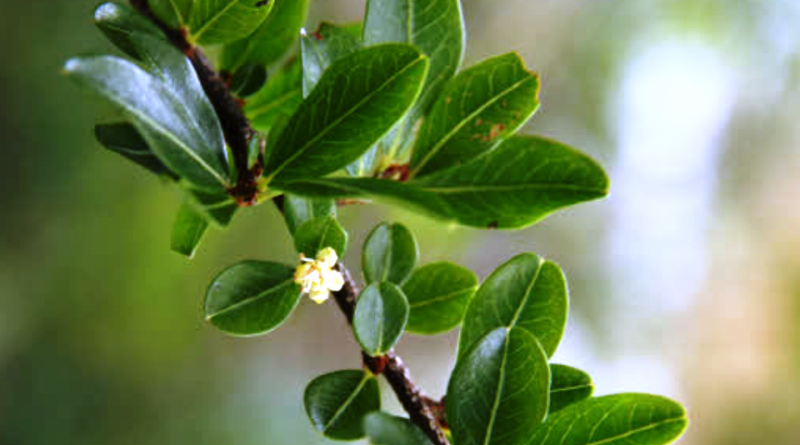Erythroxylum vaccinifolium
Erythroxylum vaccinifolium
Erythroxylum vaccinifolium, también llamado catuaba, (Erythroxylum vaccinifolium Martius 1840) es una especie de arbusto perteneciente a la familia Malpighiaceae.
Sistemática –
Desde un punto de vista sistemático pertenece a:
Dominio eucariota,
Reino Plantae,
División Magnoliophyta,
Rosidi class,
Orden Malpighiales,
Familia Malpighiaceae,
Género Erythroxylum,
E. vaccinifolium.
El término es sinónimo:
– Erythroxylum catuaba AJSilva ex Raym.-Hamet, 1936.
Etimología –
El término Erythroxylum es la unión de las palabras griegas erythr-, erythros, red y ξύλον xýlon wood.
El epíteto específico vaccinifolium se refiere a Vaccinium, que proviene de baccínium, conectado con el diminutivo de bácca berry: que produce pequeñas bayas y de folium hoja: con hojas similares a las de las plantas de ese género.
Distribución Geográfica y Hábitat –
Erythroxylum vaccinifolium es una planta originaria de las regiones tropicales del centro y noroeste de América del Sur y distribuida en un área que incluye el noreste de Brasil, el sureste de Brasil y el centro-oeste de Brasil.
Description –
Erythroxylum vaccinifolium is a very branched shrub, covered with a reddish rind. It has alternate leaves of an intense, oval, whole and isolated green. It has small pentameric flowers, white-yellowish actinomorphic, isolated or grouped at the leaf axil, with 10 concrescendo stamens at the base and 3 carpels which constitute a trilocular ovary which, when ripeness presents only one loggia. The fruit is a small reddish drupa containing only one seed.
Cultivation –
Erythroxylum vaccinifolium is a plant that grows in nature in areas of the Amazon rainforest and collected for medicinal uses.
Customs and Traditions –
Erythroxylum vaccinifolium is a Brazilian endemic plant used in traditional medicine and locally known as catuaba, which has been used since ancient times, like other plants, to prepare an infusion used as an aphrodisiac in the phytotherapy of this country.
It contains a class of tropane alkaloids called catuabins.
Scientific research on this plant has revealed nine new tropane alkaloids that have been isolated from the bark.
All compounds were identified as tropanediol or -trol alkaloids esterified by at least one 1-methyl-1H-pyrrole-2-carboxylic acid. One of the isolated compounds was identified as a tropane N-oxide alkaloid. Their structures were determined by high-resolution mass spectrometry and multidimensional NMR spectroscopy.
Method of Preparation –
Both the bark and the leaves of this plant are used for various uses, especially of the medicinal type.
Guido Bissanti
Sources
– Acta Plantarum – Flora of the Italian Regions.
– Wikipedia, the free encyclopedia.
– Useful Tropical Plants Database.
– Conti F., Abbate G., Alessandrini A., Blasi C. (ed.), 2005. An annotated checklist of the Italian vascular flora, Palombi Editore.
– Pignatti S., 1982. Flora d’Italia, Edagricole, Bologna.
– Treben M., 2000. La Salute from Farmacia del Lord, Advice and experiences with medicinal herbs, Ennsthaler Editore.
Caution: Pharmaceutical applications and alimurgical uses are indicated for informational purposes only, they do not represent in any way a medical prescription; therefore no responsibility is taken for their use for curative, aesthetic or food purposes.


